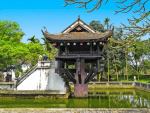Pagodas and temples reflect the cultural diversity of religious practice in Vietnam and are a focus of social, political and religious life
Each Vietnamese village has its own complex of temple buildings, including the dinh (communal house), where the village founder is venerated and the village council, an assembly of male leaders, traditionally met to debate local affairs.
Vietnamese religious practice is eclectic, and this is reflected in the layout of the temple buildings. Large temple complexes may also include a phuong dinh (front hall); ngoai cung (central hall); a noi cung or main altar hall; and a cay tien huong, which acts as a gate to the main temple complex.
The choice of temple gods also varies from one village to the next. In some temples, statues of Confucius sit alongside Daoist or Buddhist images. In the north, it is common to find Vietnam war heroes joining the statue line up. More than one dinh offers the chance to burn joss sticks before a life-size statue of Ho Chi Minh.
After 1945, religious activity was discouraged but since the 1980s there has been a revival and many Vietnamese have donated money towards temple renovations in their villages.
Each Vietnamese village has its own complex of temple buildings, including the dinh (communal house), where the village founder is venerated and the village council, an assembly of male leaders, traditionally met to debate local affairs.
Vietnamese religious practice is eclectic, and this is reflected in the layout of the temple buildings. Large temple complexes may also include a phuong dinh (front hall); ngoai cung (central hall); a noi cung or main altar hall; and a cay tien huong, which acts as a gate to the main temple complex.
The choice of temple gods also varies from one village to the next. In some temples, statues of Confucius sit alongside Daoist or Buddhist images. In the north, it is common to find Vietnam war heroes joining the statue line up. More than one dinh offers the chance to burn joss sticks before a life-size statue of Ho Chi Minh.
After 1945, religious activity was discouraged but since the 1980s there has been a revival and many Vietnamese have donated money towards temple renovations in their villages.
